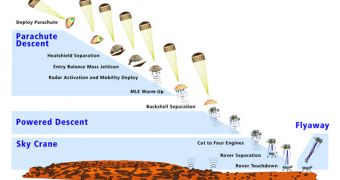Experts at the NASA Jet Propulsion Laboratory (JPL), in Pasadena, California, announced the successful completion of the first-ever assessments of the Sky Crane, the novel rover-deployment system that will be inaugurated as the rover Curiosity reaches Mars.
The mission, scheduled to blast off to the Red Planet later this year, and reach it around August 2012, is undoubtedly the largest and most complex ever undertaken at NASA.
There are a huge number of firsts that will be debuting with this flight, and so testing has been the word of the day at JPL since the construction efforts began.
Chief among them is the Sky Crane, a system developed specifically for Mars, and which is designed to land large cargo on the planetary surface. Other techniques, such as using a solid landing base or parachutes alone, are no longer sufficient.
The next NASA mission to our neighboring planet, the Mars Science Laboratory (MSL), features an exploration robot that is the size of a Mini Cooper and weighs nearly a ton. It is considerably larger than Spirit and Opportunity, the two rovers NASA already operates there.
Sky Crane was developed in such a manner that it would set the MSL down gently on the Martian surface. The way it will go about doing that features three stages – a parachute descent, a powered descent, and the actual Sky Crane phase.
During the former, the rover will be encapsulated between an Entry Balance Mass (EBM) and a backshell, to which a parachute will be attached. At a certain altitude from the surface, both protective “layers” will separate, and the rover will be kept aloft by the Sky Crane stage until it nears the ground.
The external module will then use a cable to lower the robot to a smooth touchdown. Once this is achieved, the cable will be sectioned, and the aptly-named Sky Crane will fly away, and crashland a few miles away.
The new tests that were conducted at JPL saw the MSL test model being dropped from the Sky Crane via the aforementioned wire. The entire crew that works on Curiosity tuned in to see the test, which was completed successfully.
The assessment was conducted so that JPL scientists working on the system could get a better view of the dynamics involved in deploying a moving rover from a moving descent module on a planet that has a portion of Earth's gravitational pull.
Despite the complexity of the landing system, its developers are confident that it will work. Granted, there are external influences that could make it fail, such as for example Martian sandstorms.
On the other hand, influences such as this one threaten all landers and rovers seeking to make their way on the surface of the Red Planet, NASA officials say. JPL experts want to improve the Sky Crane to a point where it becomes of no concern to mission controller, Universe Today reports.
Video: JPL experts talking about and explaining the recent MSL drop test Credit: NASA / JPL – Caltech

 14 DAY TRIAL //
14 DAY TRIAL //